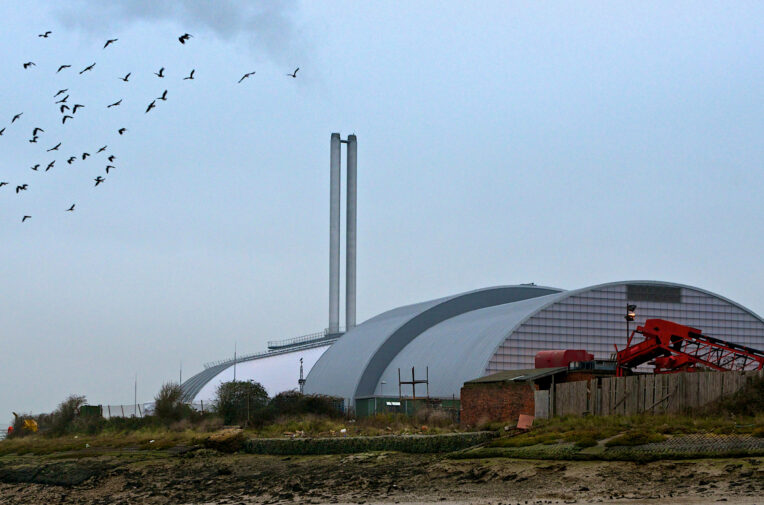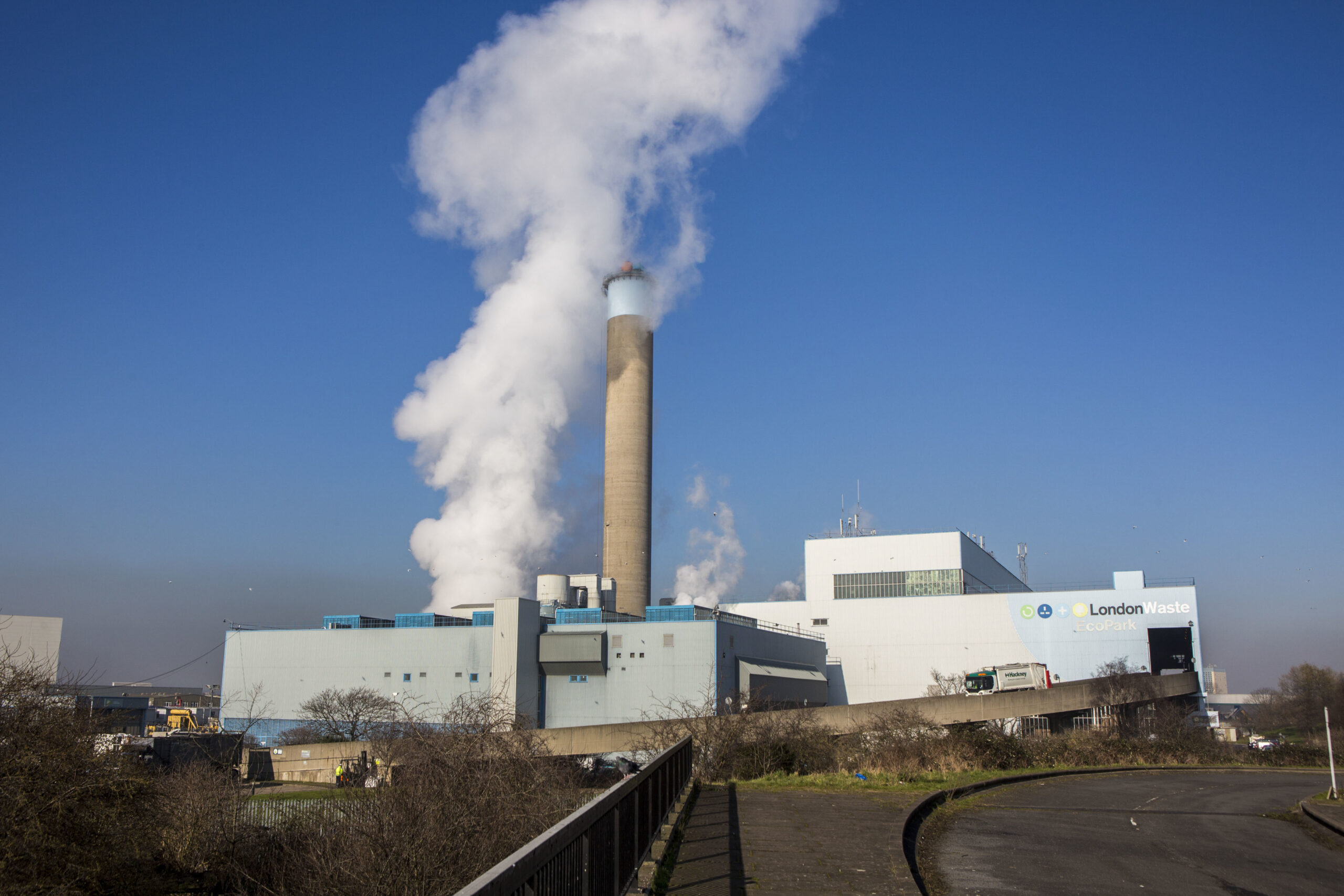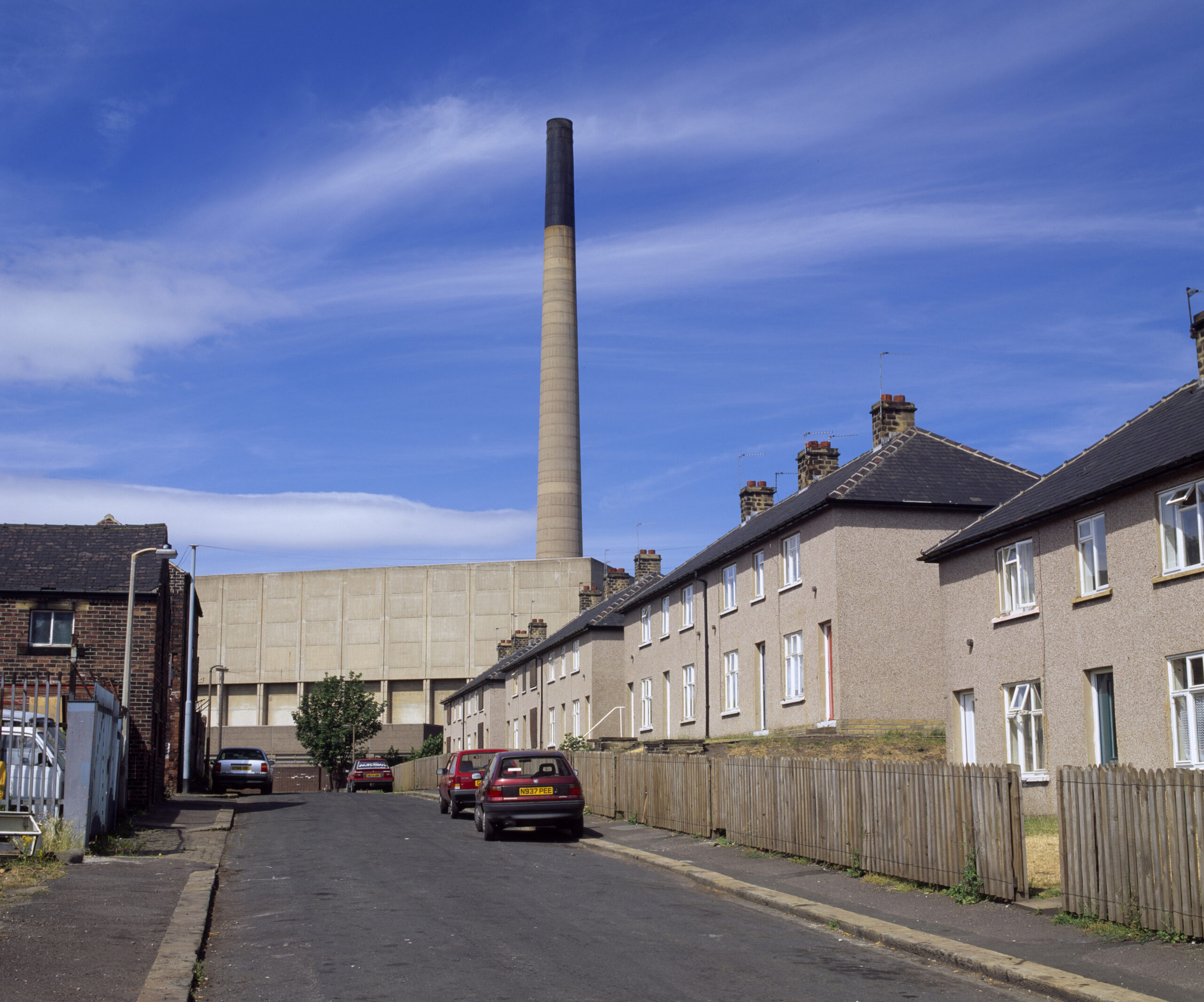
An incinerator on the banks of the river Ouse in the East Sussex town and port of Newhaven. Photo: Photofusion/Alexis Maryon/Universal Images Group via Getty Images
UK waste incinerators three times more likely to be in poorer areas
A rapidly increasing number of incinerators in the UK are being disproportionately built in low-income areas and neighbourhoods with high populations of people of colour
UK waste incinerators three times more likely to be in poorer areas
A rapidly increasing number of incinerators in the UK are being disproportionately built in low-income areas and neighbourhoods with high populations of people of colour
An incinerator on the banks of the river Ouse in the East Sussex town and port of Newhaven. Photo: Photofusion/Alexis Maryon/Universal Images Group via Getty Images
Waste incinerators are three times more likely to be built in the UK’s most deprived neighbourhoods than in the least, an Unearthed investigation has found.
Potential new incinerators – which have been proposed, are in planning or being built – also reflect this trend, according to mapping data. They are three times more likely to be built in the poorest areas than in the richest areas and nearly half are on track to be built in the UK’s top 25% most deprived neighbourhoods.
We also found that people of colour are overrepresented in the neighbourhoods where existing incinerators are sited.
Rates of incineration in England doubled between 2012 and 2018, reflecting a global trend buoyed by an international waste crisis. There are currently at least 90 incinerators in the UK and 50 more proposed or in development, according to government data and data collected by anti-incineration group UKWIN respectively. These include incinerators for municipal waste, medical waste and waste wood.
Major cities and industrial towns in England are home to the majority of incinerators, some of which are also energy-from-waste plants. More than two thirds of the potential incinerators in England are planned for the northern half of the country.
London has seven operational incinerators – the highest number in one city, although they are quite far from each other. In and around Liverpool, there are four clustered in a 10 mile radius on the banks of the River Mersey, the highest concentration in the country.
There are six incinerators operating in Scotland and two in Wales but both nations could see these numbers rise significantly. In Wales, there are six proposed incinerators – all in the areas in and around Swansea and Cardiff – and seven proposed in Scotland.
To our knowledge, there is only one industrial incinerator in Northern Ireland, located in a relatively deprived area.
Sights, sounds and smells
People living near incinerators complain of noise, litter, increased vehicle traffic, smells and air pollution – although the available evidence on air pollution from incinerators suggests the problem is much less significant than around other industrial sites.
Georgia Elliott-Smith lives near the incinerator in Edmonton, north London, which is sited in one of the poorest neighbourhoods in the country. The area also has greater diversity than the borough and national averages, with 65% of the population being people of colour.
Now, a proposed rebuild would see the incinerator increase its waste burning capacity by 200,000 tonnes.
“When you walk around the neighbourhood around this incinerator, it’s already a very industrial area,” Elliott-Smith told Unearthed. “It’s really dirty, you know. It’s not well looked after.”
“There’s waste handling areas, depots, you can drive up and see the open doors of where the waste trucks go in – and all the bushes are full of plastic bags blowing around.”
Other residents of the area have complained about smells and sounds coming from the incinerator – a frequent concern raised by those living adjacent to incinerators. As temperatures rise in the summer, the smell often gets worse, forcing people to close their windows and avoid sitting outside.
Areas with incinerators also experience greater vehicle traffic, with trucks bringing rubbish from other boroughs or counties.
The North London Waste Authority (NLWA), which manages the Edmonton incinerator, told Unearthed that odour and noise is carefully controlled in accordance with Environment Agency standards and that residual waste is stored inside the plant under strictly controlled conditions. The litter around the area is mostly due to the proximity of a major A road and fly tipping in the area, they added.
Unearthed’s findings suggest that because wealthier neighbourhoods are often perceived as more worthy of preservation and protection, the nation’s rubbish is left to be dealt with in the most deprived communities.
“A couple of weeks ago, an incinerator was rejected in Cambridgeshire because it wasn’t in keeping with the local neighbourhood, because they’ve got a lot of ancient buildings in that area,” Elliott-Smith said. “But yet, turn the page and in Edmonton, where there’s a lack of historic buildings and leafy neighborhoods, apparently [an incinerator] is in keeping with…where we live.”
“What message does it send to people to say we don’t want an incinerator in leafy Cambridgeshire, but we’re happy to put it in your backyard?”
Air pollution
Up until now incinerator emissions have been limited by EU standards, which the industry and the UK government has looked to weaken. From next year they will be decided domestically.
Local MP Kate Osamor is calling for a review of the plans to expand the Edmonton incinerator site, where ambient air pollution levels are already above EU limits.
“There is substantial evidence that incinerators of the kind proposed for Edmonton would make the crisis worse…. A study by [NGO] Zero Waste Europe has shown that even state-of-the-art incinerators emit dangerous pollutants,” she told Unearthed. “I fear for the impact on public health in Edmonton.”
The study focused on one modern incinerator in the Netherlands and projected that emissions rates weren’t being adequately monitored, and were therefore potentially much higher than records stated. The NLWA told Unearthed that the new expanded incinerator will not result in a deterioration in air quality as it will be the first in the UK to operate using selective catalytic reduction technology, which will help to bring NOx emissions at least 60% lower than required by EU law.
The main source of ambient NOx in Enfield is road transport, with key sources for particulates coming from industry and housing.
The evidence for significant local pollution increases from incinerators is small. “What’s coming out of the chimney under EU regulations, it makes a negligible contribution to people’s exposure for particulates,” said Professor Anna Hansell, who led an Imperial College study on incinerators in 2019.
In the same year, research conducted in Italy found an increased risk of cardiac and respiratory diseases among long-term residents living near an incinerator. Although the research was able to control for social factors to some extent, the authors acknowledged that their findings could also be related to individual factors like occupation and lifestyle.
“One of the problems you have is that you can’t clearly attribute the exposure source,” Hansell explained. “If you’re in a more deprived area, it becomes even harder because you might have an accumulation of industries around and your job might also be different, in terms of the exposure.”
One concern for some communities is Brexit. Pollution limits come from EU law but the UK government and waste industry have long lobbied to weaken these rules.
Earlier this year, MPs rejected an amendment to the Environment Bill that would have aligned the UK’s particulate matter targets with stricter World Health Organisation guidelines. Rebecca Pow, minister for the Department for Environment, Food and Rural Affairs (Defra) urged MPs to vote down the amendment.
In 2018, Unearthed revealed that the UK had successfully pushed to weaken new EU NOx limits from incinerators and documents obtained since through freedom of information law show that the waste industry – in spite of its green branding – lobbied the government in support of the move.
The Environmental Services Association (ESA) – the trade body that lobbied for the changes – told Unearthed that it “fully supports the adoption of rigorous standards for protecting the environment” and that energy-from-waste plants divert waste from landfill sites and provide low carbon energy.
Both government officials and the ESA denied the new clause amounted to a weakening of standards.

Racial disparities
Our data revealed that incinerators often disproportionately impact communities of colour, who are more likely to live where they operate.
By comparing demographics at incinerator sites with their local authority averages, we found that more than 40% of all existing incinerators are sited in areas more diverse than their local authority average.
Studies have already found that industrial build-up and air pollution disproportionately impact communities of colour. In 2019, the Mayor of London’s office found that Black Londoners are exposed to higher rates of air pollution, and in 2015, Imperial college research showed that air pollution is worse in diverse neighbourhoods. Now, people of colour are disproportionately dying of Covid-19, raising questions about the relationship between exposure to air pollution and community health.
“In poorer neighbourhoods, [industrial sites] are built there, amassed there,” Rosamund Kissi-Debrah, a clean air campaigner whose daughter died of asthma in 2013, told Unearthed. “If it comes to pass that Black and Asian people are not paid as much, then they’re not going to get the best houses in the best areas.”

Kissi-Debrah added that living in industrial areas worsens environmental health conditions for people of colour, and their needs are often in competition with other government priorities.
“I don’t know whether pollution and peoples’ health can compete with the economy and jobs.”
Asad Rehman, a climate justice activist and executive director of War on Want, pointed out that communities of colour often have less political sway.
“We’re already shut out of the political system because of our economic position,” he said. “When you’re living in East London and you’re working two jobs on zero-hour contracts or minimum wage, you don’t have the time to be able to devote evenings to go see your councillor.” ”
“Accountability needs to begin at the national level, with the government as a whole, because the government sets the planning guidelines, and it decides what is acceptable and isn’t acceptable,” he continued.
“Local authorities, I think, really need to take a step back and say, ‘we act in the interest of all of our citizens, and we want to guarantee the well being and the right to a dignified life for all of our citizens’.”
Nationwide waste crisis
The ability of firms and local authorities to build incinerators – despite local opposition – may also be having an impact on the UK’s recycling rates, ultimately increasing the carbon emissions from the production of virgin plastics.
While incineration is on the rise, the UK is expected to fail to meet its 2020 recycling targets. Recyclable materials are on occasion diverted to incinerators due to inadequate processing centres, and evidence submitted in a government inquiry showed that local authorities which incinerate more recycle less.
“With recycling rates flatlining, the Government should consider a tax on incineration to address climate harm and encourage more recycling,” Sharon Hodgson, MP for Washington and Sunderland West, told Unearthed.
Hodgson is one of a number of MPs around the country who have supported their constituents in anti-incineration campaigns.
The Environmental Services Association (ESA), which represents the UK waste industry, said in a written statement: “Energy recovery facilities serve a vital public function and, in accordance with the waste hierarchy, divert millions of tonnes of UK waste from landfill every year.”
“Their operation is approved by Public Health England and permitted by the Environment Agency and each plant is only granted a permit if the Agency determines it is in an appropriate location; any and all appropriate risk mitigation is in place; and the plant can meet its permit conditions. In particular, very strict emissions limits are imposed upon them and performance against these limits is monitored closely by the Environment Agency.”
They added that through community consultation and education initiatives, incinerator companies attempt to build relationships with the communities in which the plants are sited.
The NLWA told Unearthed that the Secretary of State for Business, Energy and Industrial Strategy granted consent for the project in 2017, “following extensive public consultation and public hearings, as well as careful consideration of environmental factors, air quality and an assessment of the alternatives. The project is the only proven, sustainable and cost-effective solution for treating north London’s non-recyclable waste in the future.”
A spokesperson from the Department for Environment, Food and Rural Affairs told Unearthed: “Local councils are responsible for planning how waste is managed in their areas, including determining planning applications for new energy–from–waste plants.”
“The Environment Agency will not issue an environmental permit if a proposed plant poses a significant risk to people’s health or the environment.
This map shows the locations of existing and potential incinerators across the UK, layered over neighbourhoods ranked by deprivation. The most deprived neighbourhood is ranked 1. By hovering over the incinerators, you can view their name and the deprivation ranking of the neighbourhood in which they’re sited. Sites with both an existing and potential incinerator marker are those with scheduled expansions or rebuildings.
In order to plot out the incinerator locations in England, we gathered location data from the Environment Agency’s collection of annual waste incinerator emissions reports. As the data isn’t collected in the same way for Scotland, Northern Ireland and Wales, we referred to the UK Without Incineration Network’s map of UK incinerators for the respective nations’ incinerator locations. We also used this resource to gather data on potential incinerators, which we then verified the status of. The incinerators, in total, include waste-to-energy, standard municipal and commercial waste incineration, hazardous and non-hazardous medical waste, and waste wood (biomass). Small-scale incinerators which are not monitored by the Environment Agency are excluded.
The locations were then superimposed on a map of UK deprivation by lower layer super output area (LSOA), a census unit that divides up boroughs into small neighbourhoods with approximately equal populations. Deprivation rankings are based on income, employment, education, resources, health, crime and housing. The deprivation rankings are visible on the map by colour.
The incinerators were then also mapped against the ethnic breakdown of the respective LSOA – those figures were compared to borough-wide statistics in order to understand whether the incinerators were sited in the most diverse neighbourhoods in the borough. This breakdown is not visible on the map.
Due to restrictions in the amount of data we are able to upload to the mapping software, we couldn’t include a visual representation of Northern Ireland’s deprivation data – but there is only one existing incinerator that we’re aware of, which is in one of the most deprived parts of the nation. The only potential incinerator plan for Northern Ireland in UKWIN’s records was blocked in 2018.
This story was picked up by the Guardian.
This story was amended on 31 July 2020. It previously said that rates of incineration in the UK have doubled, but the data is for England, not the UK.




